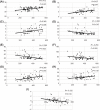Association between functional performance and executive cognitive functions in an elderly population including patients with low ankle-brachial index
- PMID: 26005338
- PMCID: PMC4427597
- DOI: 10.2147/CIA.S69270
Association between functional performance and executive cognitive functions in an elderly population including patients with low ankle-brachial index
Abstract
Introduction: Peripheral arterial disease, as measured by the ankle-brachial index (ABI), is prevalent among the elderly, and is associated with functional performance, assessed by the 6-minute walk test (6MWT). Executive cognitive function (ECF) impairments are also prevalent in this population, but no existing study has investigated the association between ECF and functional performance in an elderly population including individuals with low ABI.
Aim: To investigate the association between functional performance, as measured by the 6MWT, and loss in ECF, in an elderly sample including individuals with low ABI.
Method: The ABI group was formed by 26 elderly individuals with low ABI (mean ABI: 0.63±0.19), and the control group was formed by 40 elderly individuals with normal ABI (mean ABI: 1.08±0.07). We analyzed functional performance using the 6MWT, global cognition using the Mini-Mental State Examination (MMSE), and ECF using the Digit Span for assessing attention span and working memory, the Stroop Color Word Test (SCWT) for assessing information processing speed and inhibitory control/impulsivity, and the Controlled Oral Word Association Test (COWAT) for assessing semantic verbal fluency and phonemic verbal fluency. We also used a factor analysis on all of the ECF tests (global ECF).
Results: Before adjustment, the ABI group performed worse on global cognition, attention span, working memory, inhibitory control/impulsivity, semantic verbal fluency, and phonemic verbal fluency. After adjustment, the ABI group performance remained worse for working memory and semantic verbal fluency. In a simple correlation analysis including all of the subjects, the 6MWT was associated with global cognition, attention span, working memory, information processing speed, inhibitory control/impulsivity, semantic verbal fluency, and global ECF. After adjustment, all the associations remained statistically significant.
Conclusion: This study found an independent association between functional performance and ECF in an elderly population including low ABI individuals, showing that, in elderly populations with functional impairment, ECF may also be impaired.
Keywords: 6-minute walk test; cognition; vascular disease.
Figures

Similar articles
-
[Interest of a new instrument to assess cognition in schizophrenia: The Brief Assessment of Cognition in Schizophrenia (BACS)].Encephale. 2008 Dec;34(6):557-62. doi: 10.1016/j.encep.2007.12.005. Epub 2008 Jul 9. Encephale. 2008. PMID: 19081451 French.
-
Ankle brachial index as a predictor of cognitive impairment in the general population: ten-year follow-up of the Edinburgh Artery Study.J Am Geriatr Soc. 2006 May;54(5):763-9. doi: 10.1111/j.1532-5415.2006.00702.x. J Am Geriatr Soc. 2006. PMID: 16696741
-
Ankle brachial index and cognitive function among Hispanics/Latinos: Results from the Hispanic Community Health Study/Study of Latinos.Atherosclerosis. 2018 Apr;271:61-69. doi: 10.1016/j.atherosclerosis.2018.02.016. Epub 2018 Feb 9. Atherosclerosis. 2018. PMID: 29459267 Free PMC article.
-
The impact of carotid artery stenting on cognitive function in patients with extracranial carotid artery stenosis.Ann Vasc Surg. 2015 Apr;29(3):457-69. doi: 10.1016/j.avsg.2014.10.024. Epub 2015 Jan 13. Ann Vasc Surg. 2015. PMID: 25591487 Review.
-
Cognitive and psychomotor effects of risperidone in schizophrenia and schizoaffective disorder.Clin Ther. 2008 Sep;30(9):1565-89. doi: 10.1016/j.clinthera.2008.09.014. Clin Ther. 2008. PMID: 18840365 Review.
Cited by
-
Higher Perceived Stress as an Independent Predictor for Lower Use of Emotion-Focused Coping Strategies in Hypertensive Individuals.Front Psychol. 2022 May 24;13:872852. doi: 10.3389/fpsyg.2022.872852. eCollection 2022. Front Psychol. 2022. PMID: 35686074 Free PMC article.
-
The Factor Structure of Cognitive Functioning in Cognitively Healthy Participants: a Meta-Analysis and Meta-Analysis of Individual Participant Data.Neuropsychol Rev. 2020 Mar;30(1):51-96. doi: 10.1007/s11065-019-09423-6. Epub 2020 Feb 1. Neuropsychol Rev. 2020. PMID: 32008158 Free PMC article.
-
The association between global cognitive function and walking capacity in individuals with broad ranges of cognitive and physical function: Are there sex differences?Front Rehabil Sci. 2022 Sep 12;3:960437. doi: 10.3389/fresc.2022.960437. eCollection 2022. Front Rehabil Sci. 2022. PMID: 36188989 Free PMC article.
-
Sleep disturbance and cognitive decline in multiple sclerosis patients with isolated optic neuritis as the first demyelinating event.Int Ophthalmol. 2020 Jan;40(1):151-158. doi: 10.1007/s10792-019-01157-x. Epub 2019 Aug 20. Int Ophthalmol. 2020. PMID: 31432354
-
The relationship between functional status, physical fitness and cognitive performance in physically active older adults: A pilot study.PLoS One. 2018 Apr 9;13(4):e0194918. doi: 10.1371/journal.pone.0194918. eCollection 2018. PLoS One. 2018. PMID: 29630625 Free PMC article.
References
-
- Hirsch AT, Haskal ZJ, Hertzer NR, et al. ACC/AHA 2005 guidelines for the management of patients with peripheral arterial disease (lower extremity, renal, mesenteric, and abdominal aortic): executive summary. J Am Coll Cardiol. 2006;47(6):1239–1312. - PubMed
-
- Rooke TW, Hirsch AT, Misra S, et al. 2011 ACCF/AHA focused update of the guideline for the management of patients with peripheral artery disease (updating the 2005 guideline): a report of the American College of Cardiology Foundation/American Heart Association Task Force on Practice Guidelines. J Am Coll Cardiol. 2011;58(19):2020–2045. - PMC - PubMed
-
- Parmenter BJ, Raymond J, Dinnen PJ, Lusby RJ, Singh MAF. Preliminary evidence that low ankle-brachial index is associated with reduced bilateral hip extensor strength and functional mobility in peripheral arterial disease. J Vasc Surg. 2013;57(4):963–973. - PubMed
-
- McDermott MM, Liu K, Greenland P, et al. Functional decline in peripheral arterial disease – associations with the ankle brachial index and leg symptoms. JAMA. 2004;292(4):453–461. - PubMed
Publication types
MeSH terms
LinkOut - more resources
Full Text Sources
Medical

